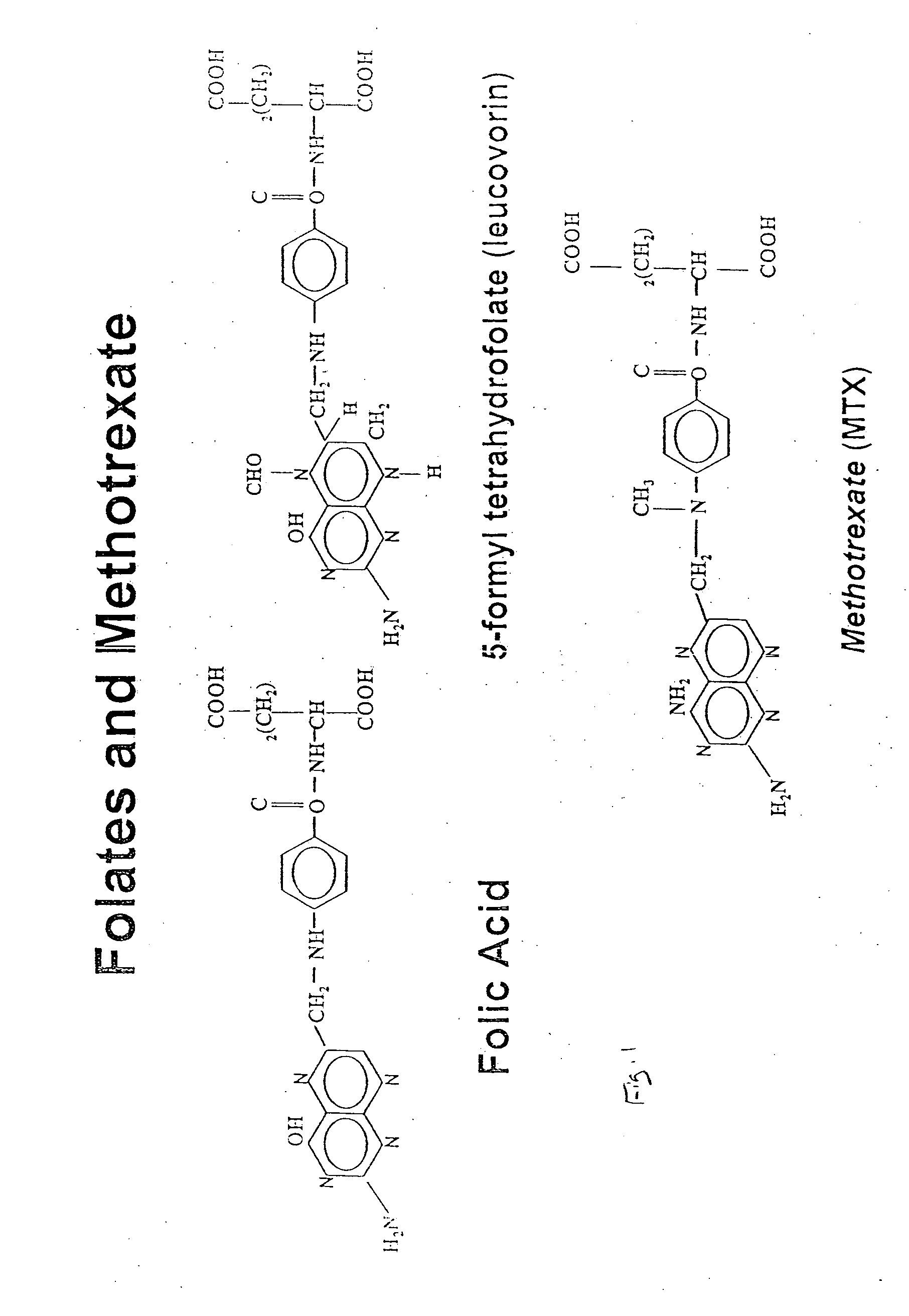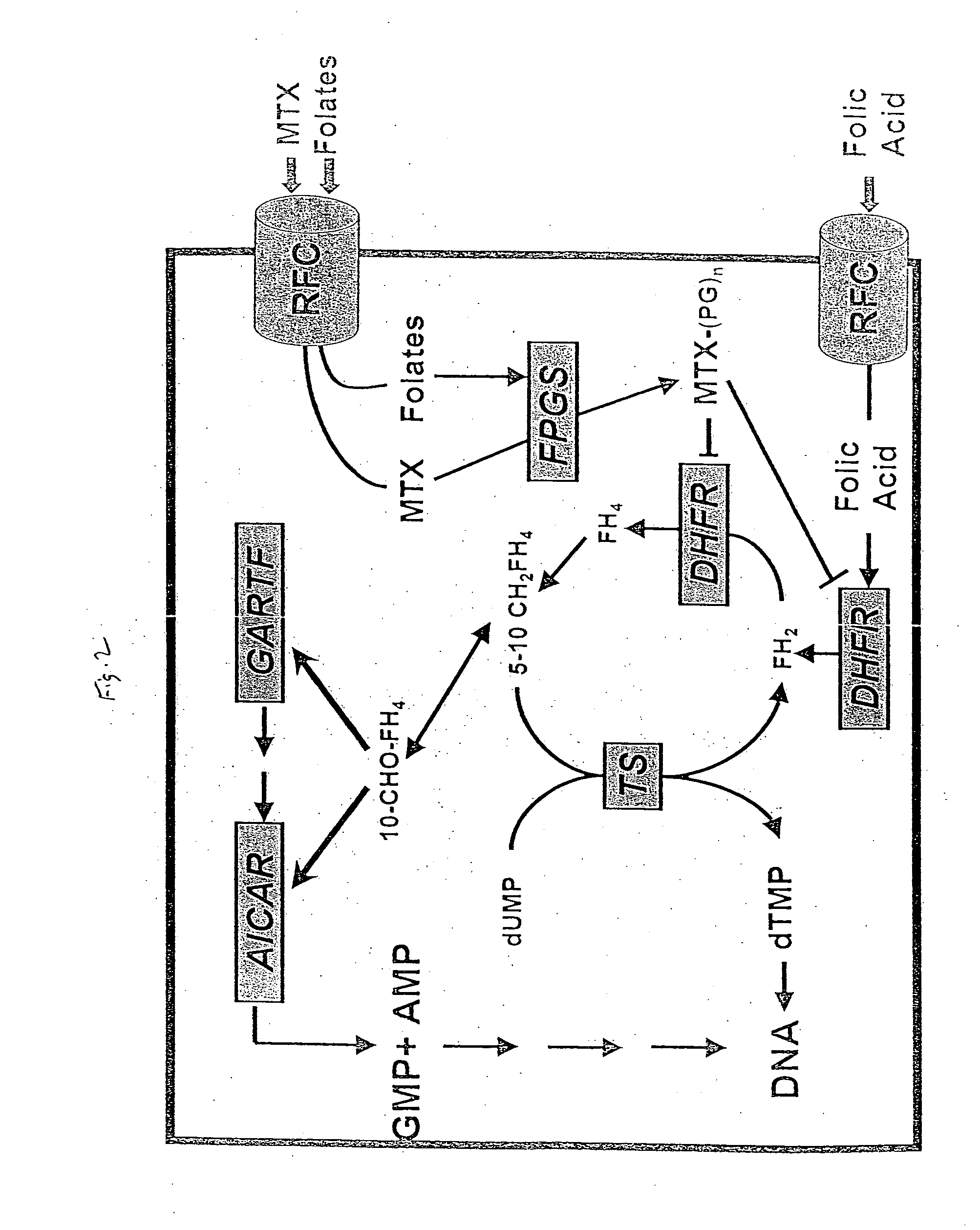As with many other anticancer drugs, the successful treatment of neoplastic diseases by antifolate-containing
chemotherapy is often limited by the frequent emergence of
drug resistance.
However,
folic acid is poorly transported via the RFC (K.sub.m200-400 .mu.M).
Although this
hypothesis per se is an attractive one (since it may guarantee electroneutrality in exchange), a number of issues have not yet been clarified.
Furthermore, anion concentrations required to trans-stimulate / inhibit MTX transport often exceed physiological levels, thus questioning the physiological relevance of this observation.
Polyglutamylation of natural reduced folates and glutamate-containing antifolate drugs renders them polyanionic and thereby results in their
entrapment within the cells.
This stands in complete contradistinction with the recently used RT-PCR and sequencing of the entire RFC cDNA which is, of course, labor-intensive, time-consuming, expensive, and above all, far from being suitable for the handling of a large number of samples.
Isolated blast cells from this patient demonstrated severely impaired MTX uptake, consistent with the complete and ultimately fatal resistance to chemotherapy observed clinically.
Consequently, this resulted in a markedly impaired MTX transport while preserving
folic acid and leucovorin uptake due to a significant loss of carrier affinity for MTX, while gaining a marked increase in the transport affinity for
folic acid.
The use of LCR for
mutant screening is limited to the examination of specific
nucleic acid positions.
However, available thermostable
DNA ligases are not effective on this
RNA substrate, so the
ligation must be performed by T4
DNA ligase at low temperatures (37.degree. C.).
While the 3SR /
NASBA, and Q.beta. systems are all able to generate a large quantity of
signal, one or more of the enzymes involved in each cannot be used at high temperature (i.e., >55.degree. C.).
Therefore the reaction temperatures cannot be raised to prevent non-specific hybridization of the probes.
In practice, routine
polymerase chain reactions rarely achieve the theoretical maximum yield, and PCRs are usually run for more than 20 cycles to compensate for the
lower yield.
Reaction conditions must be carefully optimized for each different primer pair and target sequence, and the process can take days, even for an experienced investigator.
The laboriousness of this process, including numerous technical considerations and other factors, presents a significant drawback to using PCR in the clinical setting.
Indeed, PCR has yet to penetrate the clinical market in a significant way.
This method has a substantial limitation in that the base composition of the mismatch influences the ability to prevent extension across the mismatch, and certain mismatches do not prevent extension or have only a
minimal effect (Kwok et al., Nucl.
Any mismatch effectively blocks the action of the thermostable ligase, but LCR still has the drawback of target-independent background
ligation products initiating the amplification.
Moreover, the combination of PCR with subsequent LCR to identify the nucleotides at individual positions is also a clearly cumbersome proposition for the clinical laboratory.
Traditional methods of direct detection including, Northern and Southern band RNase protection assays usually require the use of radioactivity and are not amenable to
automation.
However, specialized equipment and highly trained personnel are required, and the method is too labor-intense and expensive to be practical and effective in the clinical setting.
However, this method requires the use of
osmium tetroxide and
piperidine, two highly noxious chemicals which are not suited for use in a clinical laboratory.
RFLP analysis suffers from low sensitivity and requires a large amount of sample.
When RFLP analysis is used for the detection of point mutations, it is, by its nature, limited to the detection of only those single base changes which fall within a restriction sequence of a known restriction
endonuclease.
Moreover, the majority of the available enzymes have 4 to 6 base-pair recognition sequences, and cleave too frequently for many large-scale
DNA manipulations (Eckstein and Lilley (eds.
Furthermore, the method requires specialized equipment to prepare the gels and maintain the needed high temperatures during
electrophoresis.
In addition, long running times are required for DGGE.
This technique is extremely sensitive to variations in gel composition and temperature.
A serious limitation of this method is the relative difficulty encountered in comparing data generated in different laboratories, under apparently similar conditions.
While ddF is an improvement over SSCP in terms of increased sensitivity, ddF requires the use of expensive dideoxynucleotides and this technique is still limited to the analysis of fragments of the size suitable for SSCP (i.e., fragments of 200-300 bases for optimal detection of mutations).
In addition to the above limitations, all of these methods are limited as to the size of the
nucleic acid fragment that can be analyzed.
For the
direct sequencing approach, sequences of greater than 600 base pairs require
cloning, with the consequent delays and expense of either deletion sub-
cloning or primer walking, in order to cover the entire fragment.
SSCP and DGGE have even more severe size limitations.
Because of reduced sensitivity to sequence changes, these methods are not considered suitable for larger fragments.
The ddF technique, as a combination of
direct sequencing and SSCP, is also limited by the relatively small size of the DNA that can be screened.
 Login to View More
Login to View More 


